Higher Resolution
Astronomy was at first a visual science. Scientists peered at the skies, making catalogs of what they saw, describing forms and colors of unknown objects. Modern age astronomers also look at the sky, but they do so with much better instruments - instruments which have extended their quest to parts of the electromagnetic spectrum that our eyes can't see.
In everyday life, your eyes act as lenses and focus light onto your retina. Your brain reconstructs an image which is what you "see." Just like a photo taken with a camera out of focus, if your eyes are not working as perfect lenses, you "see" a blurred picture. (Remember the blurry images from the Hubble Space Telescope before the servicing mission repaired its faulty mirrors.)
One challenge of very high-energy astronomy - from ultraviolet and above - is the ability to build a "lens" to focus the incoming photons on a detector. The image is then reconstructed using computers to process the recorded signal. Lenses for high-energy photons have nothing in common with the ones used in optical telescopes: the high-energy lenses consist of pairs of nested, coated mirrors in paraboloid and hyperboloid shapes. The incoming photons bounce off the surface of the mirror and are directed toward the collecting area of the detector.
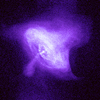 |
Figure 1:
Chandra ACIS-I image of the Crab nebula
(click on the image for a larger view). |
There are many examples of the power of high-resolution imaging to solve long-standing mysteries. Fig. 1 shows an image of the Crab Nebula obtained with the ACIS-I onboard the Chandra Observatory. The image showed the large ring and jets that had been seen previously by ROSAT. But the image also revealed the existence of a bright, small ring surrounding the center of the nebula which had never been seen. That ring is probably where the electrons accelerated by the pulsar get splattered into the nebula. The transfer was, until now, a complete mystery because the previous images were too blurred to see the details of what was happening in the region closest to the pulsar. The other spectacular features of the Chandra image (the large ring and the jets) had been detected during observations with the ROSAT satellite's HRI instrument.
Fig. 2 shows another object (the supernova remnant Cassiopeia A) as "seen" by two generations of X-ray detectors. The image of Cassiopeia A shown at the extreme right in Fig 2 was also obtained using ACIS-I. The details present in this picture allowed scientists to "see" for the first time that there was probably a pulsar, a spinning neutron star, hidden in the middle of the remnant. It appears as a small point source almost right at the center of the image. It was invisible in previous images of Cassiopeia A.
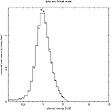 |
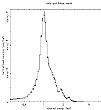 |
 |
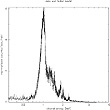 |
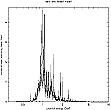 |
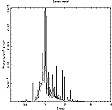 |
| click on any image for a larger view
|
|
| Figure 3:
Spectrum of an average supernova remnant as detected by five existing X-ray detectors and the theoretical spectrum. The detectors are from top to bottom, left to right: ROSAT PSPC, Einstein SSS, ASCA SIS, XXM MOS, and ASTRO-E XRS. The right spectrum at the bottom is the theoretical input.
|
Higher resolution does not only mean better images. As the need for higher resolution images increased, so did the need for higher resolution spectroscopy: the ability to distinguish between emission lines from different elements turned out to be a powerful diagnostic tool for the characterization of the object probed. Every object emits radiation which reveals its interaction with its environment: a plasma spectrum will show emission lines for all the elements present. The strength, the width and the energy of those emission lines provide crucial information about the plasma itself (its temperature, density,and composition). These sorts of studies hinge on the ability to disentangle the contributions from different elements and identify their signature line emission. Fig. 3 shows the theoretical spectrum of a young supernova remnant and the spectrum as it would have been recorded by different detectors spanning two decades of X-ray missions.
You can see at once how much easier it is to identify the contributions of all the elements present in the remnant when the energy resolution is better.
There are two main problems facing scientists who tackle high-resolution spectroscopy. One is the minuscule size of the detectors and the small portion of the sky they cover. There have been some developments to increase the size of the collecting area. The second is the difficulty in interpreting and identifying the measured emission lines. This requires reliable theoretical computations for line
emission strength or precise measurement of those lines in a laboratory (and better yet, both).
This line of research is now at the forefront of the effort in plasma astrophysics. One day, it should be possible to study the details of the chemical composition and physical condition of a plasma located thousands of light-years from the Earth.
|
